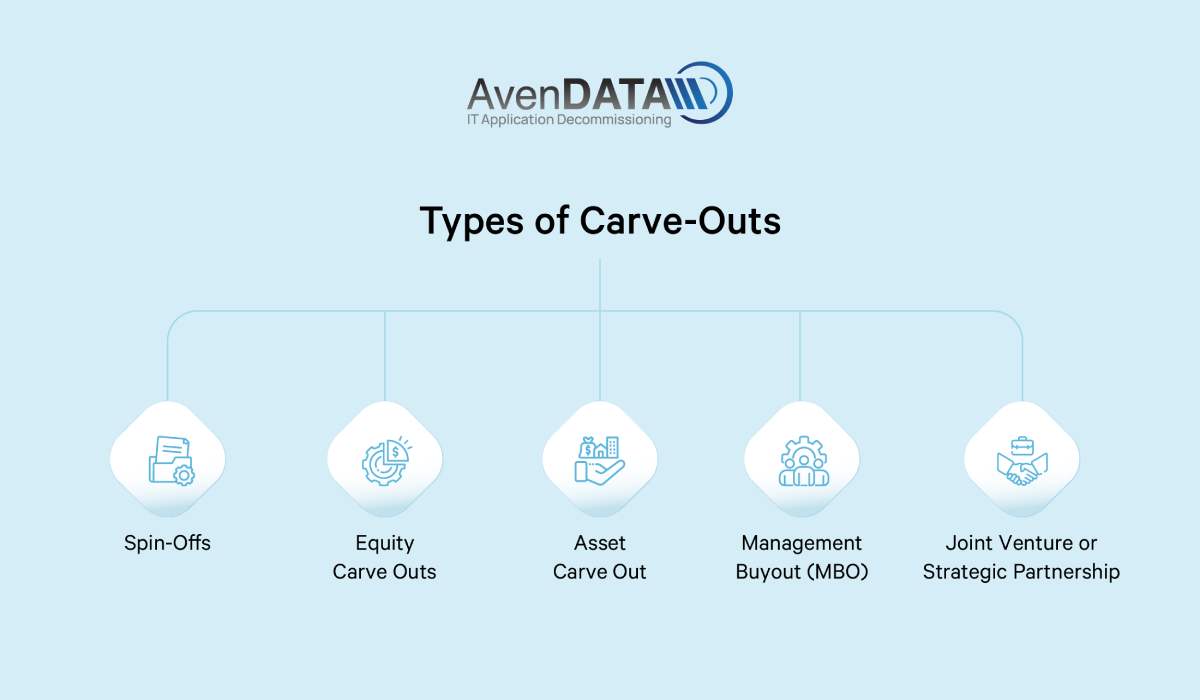Carve-out meaning:
When companies decide to sell companies or business units, this is known as a carve-out. The reasons for this can be many and varied. Carve-outs, also known as partial divestiture or de consolidation, involve the strategic separation of a business unit or assets, providing companies with a means to optimize focus and value within their operations. The carve-out process allows the subsidiary or separate entity to function independently; however, the parent company retains a degree of control and discretion. In addition to organizational and contractual challenges, this also poses a special challenge for IT.

Key features of a carve-out :
- A carved out entity that is separate from the parent company gets a free will to sell a few of its stake in the public domain through the medium of IPO.
- The subsidiary unit has a management and operations of its own, with separate legal experts, entities and analysts.
- The parent company does hold the majority of its stake in the segregated or subsidiary unit.
Types of Carve-Outs
Carve-outs are strategic initiatives that involve separating a specific business unit, division, or set of assets from a parent company to create a separate entity. This restructuring approach allows companies to focus on core operations, unlock value, and pursue new opportunities. There are various types of carve outs, each serving distinct objectives. Let’s explore some common types of carve-outs:

1) Spin-Offs
2) Equity Carve-Outs
3) Asset Carve-Out
4) Management Buyout (MBO)
5) Joint Venture or Strategic Partnership
Data Carve-out
IT Carve-out
Corporate Carve-Out

The reasons for a corporate carve-out can vary, including a desire to focus on core business activities, improve financial performance, reduce debt, or capitalize on the value of a particular business unit. Corporate carve-outs can also result from regulatory requirements or a need to streamline operations.
Carve-out Vs Spin-off
Both corporate carve-outs and spin-offs are strategies that entail the separation of a business unit or division from a larger company. However, they exhibit notable disparities concerning ownership, structure, and intent. Below, we provide an overview of the contrasts between these two approaches:
Key Differences:
| Criteria | Carve-Out | Spin-Off |
|---|---|---|
| Definition | A carve-out involves segregating a specific part or division of a company to operate independently. | A spin-off entails the creation of a new, independent company through the divestiture of an existing business unit. |
| Ownership Structure | The parent company usually retains some level of ownership or control over the carved-out entity. | The spin-off company becomes a separate, independent entity with its own ownership structure, often distributing shares to existing shareholders. |
| Independence | The carved-out entity may still have ties to the parent company, such as shared services or contractual agreements. | The spin-off company operates independently and is no longer directly tied to the parent company. |
| Motivation | Carve-outs are often driven by a desire to focus on core business operations and shed non-core or underperforming units. | Spin-offs are typically motivated by a strategic decision to unlock value, allow the spun-off unit to thrive independently, or simplify the corporate structure. |
| Financial Structure | Carve-outs may involve the parent company providing financial support or maintaining financial ties with the separated entity. | Spin-offs result in the spun-off entity having its own financial structure, including its own balance sheet and capital structure. |
| Employee Impact | Employees of the carved-out entity may still be connected to the parent company, sharing certain resources or services. | Employees of the spun-off entity become part of a new, independent organization with its own HR policies and practices. |
| Timing and Process | Carve-outs can be more complex and may involve ongoing relationships with the parent company after the separation. | Spin-offs are often more definitive, with a clear break between the parent company and the spun-off entity. |
| Example | If a technology division of a conglomerate is separated but continues to use some shared resources from the parent, it’s a carve-out. | If a pharmaceutical company spins off its consumer goods division into a separate company, it’s a spin-off. |
What is a Carve-out approach?
Carve-outs are typically driven by various motives, such as enhancing the parent company’s focus on its core competencies, improving financial performance, reducing debt, or capitalizing on the value of the divested business. This strategy enables companies to allocate resources more efficiently and prioritize their strengths.
Benefits of Carve-Outs
1. Strategic Focus
2. Value Creation
3. Flexibility and Agility
4. Access to Capital
5. Strategic Alignment and Partnership Opportunities
6. Entrepreneurial Culture and Motivation
Carve out benefits to the subsidiary
- Independence: Carving out a subsidiary can provide it with greater independence and autonomy, allowing it to make strategic decisions tailored to its own business needs.
- Access to Capital: In cases of equity carve-outs or partial IPOs, the subsidiary can raise capital by selling shares to the public or private investors. This infusion of funds can be used for growth, investment, or debt reduction.
- Enhanced Focus: As a standalone entity, the subsidiary can concentrate its resources and efforts on its core business, potentially leading to improved operational efficiency and competitiveness.
- Strategic Growth: Carved-out subsidiaries may have the flexibility to pursue strategic partnerships, mergers, or acquisitions that align with their business goals, without the constraints of the parent company.
Carve out benefits to the parent company
- Value Unlocking: Carve-out transactions can unlock the value of a subsidiary or division that may not be fully reflected in the parent company’s stock price, potentially leading to an increase in shareholder value.
- Focus on Core Business: By divesting non-core assets or businesses, the parent company can sharpen its focus on its primary operations and strategic priorities.
- Capital Generation: Equity carve-outs and asset sales can provide the parent company with an injection of capital, which can be used for debt reduction, reinvestment in core business areas, or other corporate purposes.
- Risk Mitigation: Separating a subsidiary can help the parent company isolate and limit its exposure to risks associated with that business unit, potentially insulating the core business from adverse developments.
- Streamlined Operations: A successful carve-out can lead to streamlined corporate operations, simplified financial reporting, and reduced administrative overhead.
- Strategic Flexibility: The parent company gains flexibility to enter into new strategic partnerships, mergers, or acquisitions that align with its core business without the constraints of non-core subsidiaries.
Examples of Carve-Outs
Hewlett-Packard (HP) and Agilent Technologies
General Electric (GE) and Synchrony Financial
Objectives of Carve Outs
1. Focus on Core Competencies
2. Unlock Value
3. Strategic Focus and Flexibility
4. Capital Generation
5. Entrepreneurial Culture and Accountability
6. Strategic Partnerships or Alliances
Understanding the Carve-Out Process:
The carve-out strategy involves separating a subsidiary or business unit from its parent company, transforming it into a standalone entity. Through this transition, the newly formed organization gains its own board of directors and financial statements, enabling it to operate independently. Although the parent company usually maintains a controlling interest, it also provides strategic support and resources to ensure the success of the carved-out business. Unlike a spin-off, the parent company receives a cash inflow as a result of the carve-out, further enhancing its financial position.
What makes a carve out so technically complex?
The Impact of Carve-Outs on Mergers & Acquisitions
Mergers and acquisitions (M&A) are strategic transactions that often involve the consolidation of companies to achieve synergies, enhance market presence, or drive growth. However, within the realm of M&A, another noteworthy strategy emerges – the carve-out. A carve-out refers to the process of divesting a specific business unit or division from a larger organization to operate independently or be acquired by another entity. This article explores the impact of carve-outs on M&A activities, shedding light on how this strategy can yield unique advantages and challenges.
The Advantages of Carve-Outs in M&A
Carve-outs introduce a range of advantages in the M&A landscape. Firstly, they enable companies to focus on their core competencies by shedding non-core assets, which can lead to increased operational efficiency and profitability. Additionally, carve-outs offer the opportunity to unlock hidden value within a business unit that might be overlooked within a larger conglomerate. This value realization can be particularly appealing to investors and acquirers.
Furthermore, carve-outs facilitate the strategic alignment of resources. By divesting a non-core business, companies can allocate resources more effectively to their core operations, driving growth and innovation. Additionally, carve-outs can attract specialized investors who are specifically interested in the divested business’s unique offerings.
What questions should be addressed before executing a carve out?
- What data needs to be carved out?
- Can this data be identified via a company code or client?
- Which systems contain the data to be archived?
- Which time period is relevant?
- Are there individual developments within the system that would have to be taken into account?
- Is there a need to anonymize or delete data prior to extraction due to DSGVO requirements?
- Is there a specific timeline by when the extraction must be completed?
- Should data be transferred to the new productive system?
How can a carve out project be organized?
- Analysis: Performing the analysis on the data scope, system and data content.
- Project planning: creation of a project plan taking into account the timeline as well as key milestones
- Test run: testing of the developed programs for extraction and migration
- Execution: Implementation of the milestones according to the project plan
- Validation: testing of the data
- Documentation: Logging of all implemented activities including application tests.
What significance will carve outs have in the future?
In which industries does AvenDATA have experience with carve outs?
A carve out refers to the process of selling companies or business units. When companies decide to sell companies or business units, this is known as a carve out.
-
How Legacy Systems Work and Their Architecture
-
Legacy Systems in Digital Era:
-
SAP Carve-Out Guide: Definition, Process, Benefits
-
System Decommissioning: A Strategic Guide
-
20 Reasons why legacy ERP systems must be archived and data should not be deleted
-
IT Mergers and Acquisitions: The ABCs of a Successful Integration
-
Mastering IT M&A and Carve-Outs: Addressing Pain Points with Practical Solutions
-
Modernizing Legacy Systems: A Strategic Guide for IT Company Owners
-
The importance of legacy systems is steadily increasing
-
Ten Key Questions with Emanuel Boeminghaus




